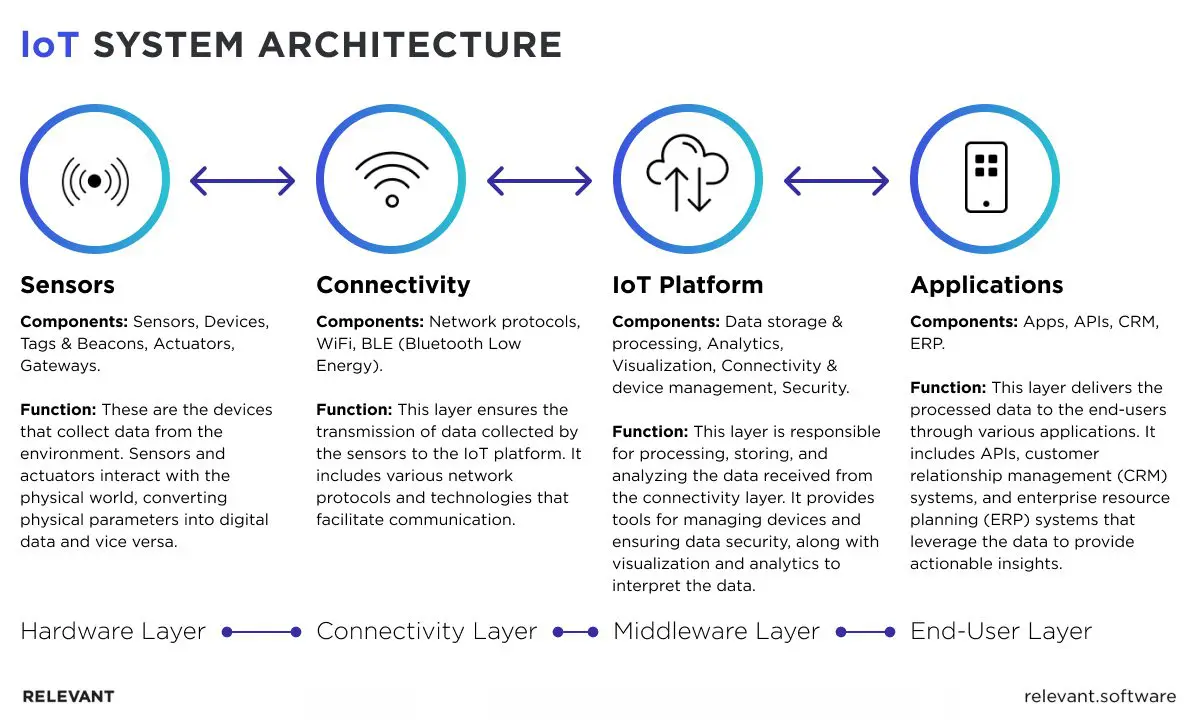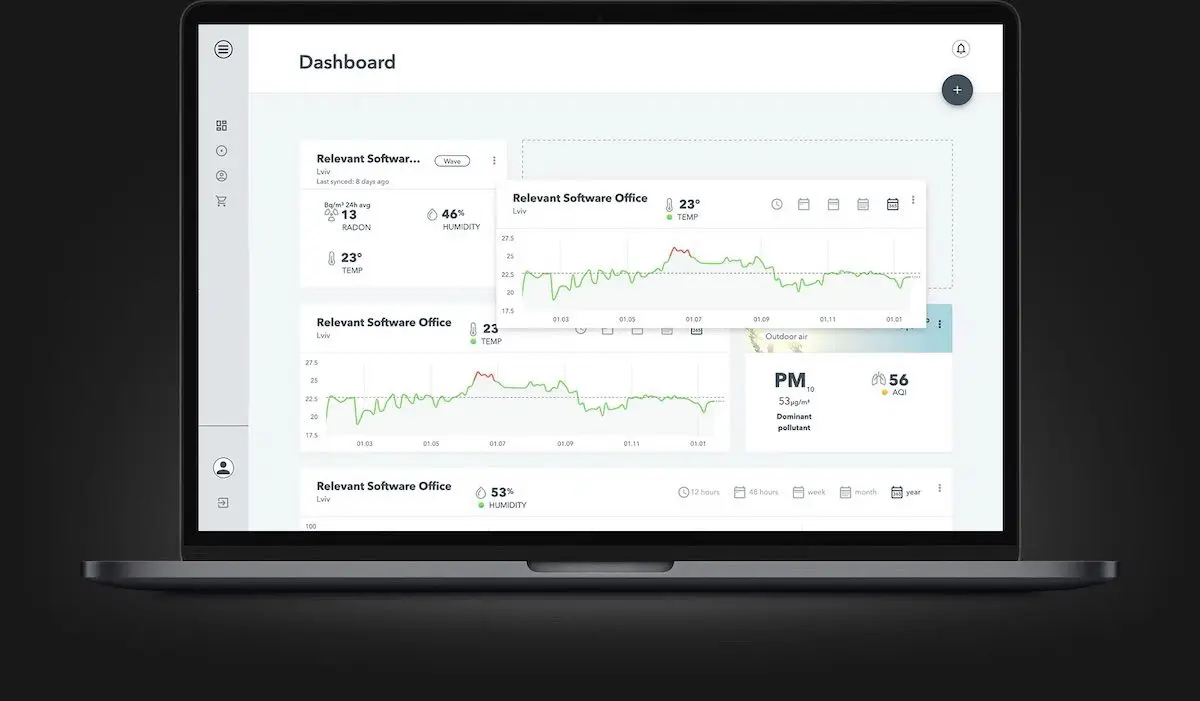Challenges IoT Connectivity Management Platforms Implementation and Ways to Overcome Them

Today, IoT devices have become omnipresent—from homes and workplaces to entire cities, invented to operate with IoT technology. Statista predicts these devices will rise from 15.9 billion in 2023 to over 32.1 billion by 2030. Amazing, wouldn’t you say? Yet, running an IoT network isn’t without its challenges, such as combining different components, upholding robust security, and ensuring smooth connectivity. Likely, many of these issues can be effectively resolved with an IoT connectivity management platform.
Nonetheless, these platforms, like the IoT industry itself, are relatively new and can be quite complex. But we will not leave you in the dark. In the following article, we’ll break down what an IoT connectivity management platform is, its must-have features, and the hurdles you might face. As IoT development experts, we also provide actionable strategies to address these challenges. So, scroll down – it will be insightful!
What is an IoT Connectivity Management Platform?
IoT solutions encompass far more than just connecting a device to the Internet. Many solutions integrate hundreds, if not thousands, of devices, often with multi-technology connectivity or functioning in challenging environments like underground locations or within complex structures.
In some cases, these solutions must manage different carrier partnerships to ensure mobile device coverage, particularly in fleet and logistics operations. This complexity often requires handling multiple technologies, contracts, and systems for billing, usage, and support.
Managing this fragmented connectivity can be daunting for organizations utilizing IoT or OEMs selling IoT-enabled applications. This is why connectivity management platforms have become indispensable in the IoT ecosystem.
An IoT Connectivity Management Platform (CMP) acts as the central hub for all your Internet of Things (IoT) devices. With an IoT CMP, you can monitor device status, manage network usage, and seamlessly implement security protocols from a single platform.
But what exactly are the components connected in the IoT ecosystem?
Firstly, there are the hardware components: the cellular radio module, the SIM card, the application, and the devices themselves. These are the physical, deployable parts of your IoT system.
Then, the software runs on these physical parts, creating your complete IoT solution. For example, the thermostat is the hardware in a smart thermostat system, while the software adjusts temperatures based on user preferences or external conditions.
Connectivity technologies form the third component. Depending on your needs, this can include 2G, 3G, LTE (4G), LTE-M, or 5G. For instance, you might need a cellular method to penetrate thick walls in an office building. In contrast, in rural areas, you need a technique that reaches long distances without sacrificing quality.
An IoT management platform helps you cost-effectively manage these hardware components, the software running on them, and the various types of connectivity. It’s like a home heating system: you set the time it should be on, the temperature, which rooms to heat, and even sync it to the weather outside.

Related – How to control IoT devices
IoT Connectivity Management Platform: Key Features
A comprehensive, fit-for-purpose CMP is essential for organizations that seek to deliver successful, high-performance IoT projects. A CMP helps organizations reduce the overheads tied to large-scale IoT connectivity and greatly enhance their control. To get a deeper understanding of the key features that modern IoT connectivity platforms must have, read on.
1. Real-Time Device Provisioning
A top-notch IoT management platform should simplify the process of onboarding new devices to the network, ideally with a single click. That can involve automated configuration, credential management, and security measures to ensure secure device enrollment. Credential management ensures that only authorized devices get added to the network.
2. Device and Network Management
The managed IoT connectivity platform must remotely manage devices, send firmware updates, configure settings, and trigger actions based on pre-defined conditions. A robust solution should work with various network types, from cellular to LPWAN, and support dynamic network selection, enabling devices to switch based on real-time factors like signal strength, data usage costs, and roaming charges.
3. Visualization and Reporting
An effective IoT connectivity platform must provide customizable dashboards. These dashboards should be filterable, configurable, and downloadable, showcasing crucial metrics like usage device performance, connectivity metrics, and data usage. Also, the platform must generate alerts for critical events like device failures or unexpected data patterns.
For more insights, read the article – How To Build an IoT Dashboard
4. Usage Monitoring
Monitoring usage is a critical aspect of any IoT connection management. The platform must provide real-time insights into the health and status of your connected devices and monitor factors like connectivity strength, battery life, and potential errors.
5. Diagnostics Tools
For businesses that deploy an IoT management platform, access to real-time status updates of individual subscriptions and event histories is crucial. This feature should allow users to perform tasks such as de-registering SIMs or issuing device reset commands. Comprehensive diagnostics ensure quick issue resolution and maintain the reliability of IoT operations.
6. Data Collection and Preprocessing
The preprocessing collects data from your connected devices and streamlines it to your chosen data storage or analytics platform. This allows for centralized data management and facilitates further analysis and visualization. The best IoT device management platforms must perform basic data preprocessing, aggregation, and formatting tasks. This ensures the data is clean and ready for further analysis in your chosen data analytics tools.
7. Analytics Instruments
Powerful analytics tools embedded within the platform are crucial in extracting meaningful information and transforming raw data into actionable intelligence. Interactive charts, graphs, and visual aids they bring help you explore trends, identify patterns, and gain deeper insights into your connected devices and the data they produce.
8. Integration Capabilities
Integration capabilities are vital for seamless IoT connection management. A robust platform should support the integration of IoT connectivity management functionalities directly into primary IoT applications and back-office systems through an extensive API library and SDKs. This integration supports automation and enhances the overall efficiency of IoT deployments.
9. Security Features
Cybersecurity Ventures predicts global cybercrime costs will reach $10.5 trillion annually by 2025, making it clear that enhancing cybersecurity is crucial. While some security measures are built in during device manufacturing, customers must also maintain security. Reliable IoT managed services enhance cybersecurity by providing a private, secure network, VPN access to the device cloud, and traffic control through a network-based firewall.
10. Scalability
An IoT system without room for growth is a costly dead-end. The IoT device management platform should effortlessly accommodate growth, with cloud-based solutions offering flexible scalability. When expanding, it’s vital to check how the software manages the extra data load and supports various network architectures.
The range of functionalities that should be considered for CMPs has grown significantly in recent years. The term “CMP” itself barely captures the full scope of what these platforms now offer. While basic SIM management and billing are common, the real differentiators are emerging in core network functions, eSIM/remote SIM provisioning, cloud connectors, advanced analytics, and even managed connectivity services.

Challenges and Solutions in Implementing IoT Connectivity Management Platforms
A study by Help Net Security revealed some alarming issues after analyzing over 5 million IoT devices:
- Organizations often do not know which devices are deployed.
- Many devices use outdated operating systems.
- “Shadow” IoT devices are deployed without anyone’s knowledge.
- Insecure network setups allow devices access to various LAN resources without sufficient isolation.
These findings highlight the complexities and risks inherent in IoT deployments. Yet, these obstacles can be effectively managed or avoided with a strategic approach and the right IoT managed services. Subsequently, we will examine some typical connectivity issues and discuss strategies to overcome them.
Complex IT Architecture
Challenge: Complex IoT architecture poses a significant challenge when implementing an IoT device management platform. Many existing systems are already overloaded and struggle to accommodate new devices and databases effectively. Legacy systems, often rigid and inflexible, cannot easily scale to meet growing demands. This inflexibility often leads to bottlenecks, reduced performance, and an inability to fully leverage the benefits of IoT.
Solution: Upgrading your infrastructure is essential to accommodate new devices and data. This requires an investment in modern hardware and software designed to manage increased demands. Also, switching to a microservices architecture can significantly improve flexibility and scalability. This way, you can develop, deploy, and scale each part individually. This modular approach simplifies updates and integration and ensures the system remains robust and adaptable as the IoT landscape evolves.
Data Handling Struggles
Challenge: IoT devices generate massive amounts of data, but most of it (about 80 percent) is unstructured. Companies that have structured data frequently don’t have the necessary tools to leverage it properly, missing out on growth and expansion opportunities.
Solution: Invest in tools that manage and analyze data from IoT device management platforms. Natural Language Processing (NLP) and Natural Language Understanding (NLU) tools help accurately label unstructured data. Data analytics tools give insights that allow executives to make informed, growth-focused decisions. By leveraging these technologies, businesses can unlock the full potential of their IoT data.
Interoperability Problems
Challenge: One incredible aspect of IoT connectivity solutions is the limitless ways to tailor your tech stack to meet your needs. However, this flexibility also brings the challenge of device heterogeneity. Connecting devices from different manufacturers with varied communication protocols can be difficult because not all IoT devices and solutions are compatible with each other or your business systems. Introducing new hardware and software may even require adjustments to maintain functionality.
Solution: Adopting universal standards and protocols like MQTT and CoAP creates a more cohesive IoT ecosystem. With these widely accepted protocols, different devices and platforms can communicate efficiently. In turn, middleware solutions can help bridge gaps between incompatible systems, leading to smoother data exchange and interaction. By standardizing protocols and middleware, you can overcome interoperability challenges and build a more efficient IoT ecosystem.
Regulatory Compliance
Challenge: Several government regulations and compliance requirements manage the development, implementation, and use of IoT devices. Enterprises must meet these requirements at every stage. Additionally, these regulations change frequently, which means constant updates to ensure compliance. Adjusting IoT infrastructure to meet new regulations can disrupt business operations. For enterprises that rely heavily on IoT, continually checking and updating for compliance can become a significant drain on time and resources.
Solution: Working with a service provider who integrates compliance into every part of their offerings can make a huge difference. This partnership ensures that enterprises stay up to date with the latest regulations without having to manage the complexities themselves. The service provider handles compliance, which allows businesses to focus on their core operations without the headache of regulatory updates.
Security Concerns
Challenge: When IoT devices and systems are integrated, they generate, transmit, and store large amounts of data. This data is valuable for business insights but also poses significant security risks. Many IoT devices come with default security settings that fall short of organizational standards. Without standard security protocols, the network’s weakest link becomes an easy target for cybercriminals.
Solution: Regularly update firmware and software to address vulnerabilities and enhance security measures, as well as remote firmware over-the-air updates. Conduct security audits and use intrusion detection systems to identify and mitigate potential threats. Develop thorough security policies and train your staff regularly to follow best practices.
Privacy Issues
Challenge: The use of IoT devices involves the collection of sensitive information, which raises privacy concerns for both individuals and organizations. Data such as personal identifiers, locations, health stats, and usage habits need to be well-protected to ensure trust and comply with data protection laws like GDPR. Without adequate safeguards, there’s a risk of misuse or unauthorized access, which can result in identity theft, financial harm, and significant reputational damage to businesses.
Solution: To ensure privacy for your IoT connectivity solutions, follow privacy-by-design principles, integrating privacy considerations throughout the IoT development process. This includes data minimization, transparency, and user control over their information. Employ advanced encryption standards and multi-factor authentication to prevent unauthorized access.
Data Inconsistency
Challenge: Data inconsistency often plagues IoT systems, where disparate platforms struggle to keep information synchronized and reliable. A lack of consistency often results in flawed insights and subpar decision-making.
Solution: Implementing data integration and synchronization tools can solve this problem. These solutions ensure that data from various sources aligns correctly, providing a cohesive and accurate picture. Usage of master data management (MDM) systems is another effective approach. MDM systems uphold data integrity by serving as the central source of truth, ensuring all platforms access consistent and reliable data. Through these methods, businesses can remove data inconsistency and create smoother and more efficient IoT operations.
Long-Term Investment
Challenge: While the benefits of IoT implementation are substantial, they may not be immediately apparent. This can make it challenging for organizations to justify the expenditure, especially when faced with other budget priorities. It’s important for decision-makers to recognize that IoT platform adoption is a long-term investment that will yield dividends over time.
Solution: Organizations should create a precise IoT implementation roadmap to overcome this challenge. This roadmap should list the projected benefits, costs, and timelines. By establishing clear expectations and tracking progress against defined milestones, businesses can demonstrate the value of IoT investments to stakeholders and ensure support for their digital transformation process.
Limited Expertise
Challenge: The field of IoT is relatively new, and finding professionals with the specific skillset required to manage IoT CMPs can be difficult. According to research by Inmarsat, half of businesses lack the in-house expertise in security, data science, and connectivity required to develop, implement, and manage IoT projects.
Solution: Specialized training programs and certifications can help your team acquire the necessary skills. This keeps everyone up-to-date with the latest technologies. Partnering with academic institutions and industry leaders can also help bridge the expertise gap. These collaborations give you access to new research and emerging talent.
If immediate managed connectivity services are needed, consider outsourcing certain tasks. By hiring IoT developers from managed service providers help you get the expert knowledge you need without the burden of a long-term commitment.
You see, creating IoT systems is far from straightforward. As Benoit Lheureux, research VP at Gartner, states, “IoT projects often come with disruptive business models, and the potential complexity can get lost in the enthusiasm.” However, if you collaborate with expert IoT service providers, the actual implementation process may proceed smoothly without significant issues.
Our IoT Projects
You may ask if we have the direct experience needed for these IoT connectivity platform implementation challenges. Of course, we have both thorough IoT technology knowledge and practical software development skills. Here are two of our success stories to convince you:
Sensor Innovation Upgrade: From Clunky UI to Seamless Sensor Management
Sensor Innovation uses sensors and smart algorithms to alert users about issues like water leaks in both industrial and residential settings. These sensors monitor humidity and temperature, factoring in weather conditions to provide accurate data and enable real-time responses.
When Sensor Innovation came to us, they had a solid product, but the user interface was clunky, and the system wasn’t as efficient as it could be. Our task was to revamp the UI and add new functionalities, such as displaying data on a building’s virtual blueprint.

We quickly put together the perfect team and used the latest tools to keep everything on track and within budget. A product manager, a UX/UI designer, and two full-stack developers – got to work.
We designed a user-friendly dashboard that makes it much easier to handle company info, user accounts, building details, and connected devices. Users can now set up virtual maps of where their sensors are, keep an eye on humidity and temperature, and create detailed performance reports.
The upgraded platform is far superior to the old one. The weather timeline feature minimizes false alarms, while virtual building maps ensure optimal sensor coverage. We made sure the site performs flawlessly on mobile devices and tablets, enabling easy sensor management from any device.
Airthings Transformation: Advanced Data Visualization and Monitoring for Global Air Quality
Airthings, a Norwegian tech company, has produced indoor radon monitoring products since 2008. They needed a custom dashboard to display air quality data from their devices to users and to monitor all their devices worldwide. Also, Airthings required real-time data collection, processing, and visualization from IoT devices. The data from each device had to be shown to its owner and be available to Airthings managers globally. With many devices displayed on an interactive map, optimizing performance to avoid lag was crucial.
A new dashboard for the Airthings website, developed by engineers, connects all devices and can be customized according to user preferences. A map we create shows the location and data from each device, using clustering to reduce load times and enhance rendering speed.

We introduced a monitoring and alert system that tracks multiple rooms and sends notifications when air quality is poor. The dashboard is highly flexible, letting users add, remove, drag, drop, and resize tiles as desired. Users can also export data in a CSV file for further analysis. Device tiles summarize sensor data, while sensor tiles display data from individual sensors.
We optimized Mapbox to download images from multiple domains for faster loading. Server-side rendering and Mapbox tweaks eliminated lag during transitions, while raster images improved map loading and rendering speeds.
The new solution we developed for Airthings opened up growth, marketing, and radon-level analysis opportunities. Airthings can now attract and engage more users with the convenient dashboard, monitor their devices globally, and identify potential new markets. Customers are also pleased to track their indoor air quality easily.
Implement IoT Connectivity Management Platform with Relevant Software
Our clients know the rule: “If you build it, you own it.” This captures the big advantage of creating custom solutions: you get full ownership and control.
When you build your own IoT connectivity platform, you keep the intellectual property rights and can tailor everything to fit your exact needs. This means you can integrate seamlessly with your existing equipment and design the user experience just the way you want it.
But to make this happen, you need a reliable partner, and Relevant is here for you. With our profound IoT expertise, we ensure your platform will be scalable, secure, and future-ready, just as we have done for our clients.
From the initial concept to deployment, our team is with you every step of the way, providing the technical know-how and support needed to create a robust IoT connectivity management platform. Contact us to get the product you’ll be proud of.



